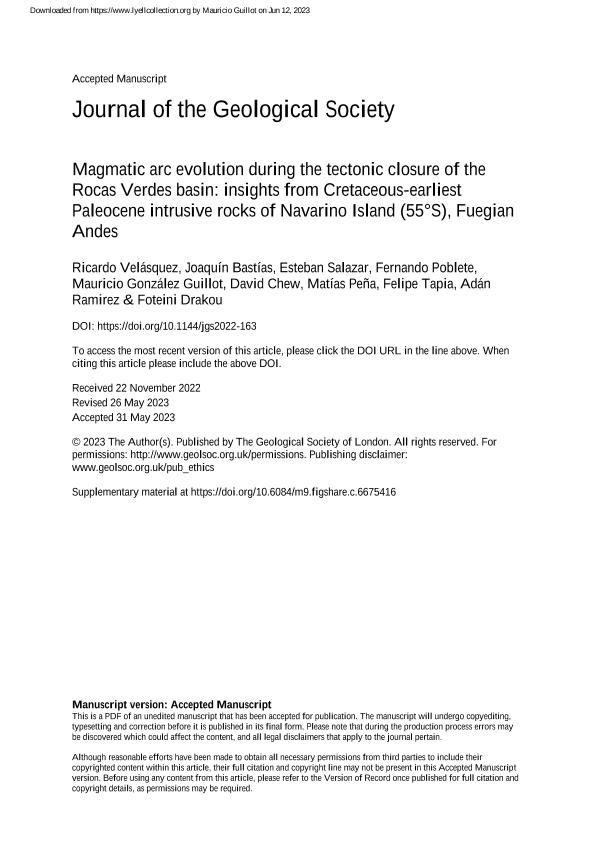Artículo
Magmatic arc evolution during the tectonic closure of the Rocas Verdes basin: insights from Cretaceous–earliest Paleocene intrusive rocks of Navarino Island (55°S), Fuegian Andes
Velásquez, Ricardo; Bastías, Joaquín; Salazar, Esteban; Poblete, Fernando; Gonzalez Guillot, Mauricio Alberto ; Chew, David; Peña, Matías; Tapia Silva, Felipe Fernando
; Chew, David; Peña, Matías; Tapia Silva, Felipe Fernando ; Ramirez, Adán; Drakou, Foteini
; Ramirez, Adán; Drakou, Foteini
 ; Chew, David; Peña, Matías; Tapia Silva, Felipe Fernando
; Chew, David; Peña, Matías; Tapia Silva, Felipe Fernando ; Ramirez, Adán; Drakou, Foteini
; Ramirez, Adán; Drakou, Foteini
Fecha de publicación:
06/2023
Editorial:
Geological Society Publications House
Revista:
Journal of the Geological Society
ISSN:
0016-7649
Idioma:
Inglés
Tipo de recurso:
Artículo publicado
Clasificación temática:
Resumen
Navarino Island is located in the southernmost part of the Fuegian Andes, south of the Beagle Channel. Its geological record documents the complex tectonic history of Tierra del Fuego that includes the opening and closure of the Rocas Verdes basin, Cordillera arc collision and subsequent subduction processes. The geology of the island is mostly comprised of the Cretaceous Yahgan Formation, a marine meta-sedimentary sequence, which is intruded by diverse plutons that are mostly exposed on the northwestern tip of the island. We herein present a new dataset that shows the presence of three Cretaceous-earliest Paleocene magmatic suites of active margin magmatism emplaced during the early stage of the Fuegian Andes, which are referred to as (i) the Dientes de Navarino Microdioritic Sills, a suite of pre-tectonic microdioritic sills that formed during ~101-97 Ma; (ii) the Castores Plutonic Complex, a series of pre- to syn-tectonic gabbroic to tonalitic plutons emplaced during ~90-87 Ma and (iii) the Samantha Monzonites, a suite of isolated monzonitic to monzodioritic post-tectonic plutons that formed at ~66-65 Ma. These distinct magmatic episodes are recognised by field observations, geological mapping, petrography and whole-rock geochemistry integrated with amphibole and biotite 40Ar/39Ar and U-Pb zircon LA-ICP-MS geochronology. The geochemical compositions of these rocks are consistent with a continental arc setting that formed during the interval ~101-65 Ma. While the three pulses spatially overlap in Navarino Island, the arc magmatism shows a migration (or expansion) throughout the Late Cretaceous. The locus of the arc then migrated at ~68-66 Ma towards the southwest. We suggest that this trench-ward migration at ~68-66 Ma may be associated with a change in the subduction angle. The three Cretaceous- earliest Paleocene plutonic pulses recorded in Navarino Island formed during the early stages of development of the Fuegian Andes, and are pre-, syn-and post-tectonic with respect to a major compressional event caused by the collision and obduction of the back-arc Rocas Verdes oceanic floor.
Palabras clave:
FUEGIAN ANDES
,
PATAGONIA
,
CRETACEOUS
Archivos asociados
Licencia
Identificadores
Colecciones
Articulos(CADIC)
Articulos de CENTRO AUSTRAL DE INVESTIGACIONES CIENTIFICAS
Articulos de CENTRO AUSTRAL DE INVESTIGACIONES CIENTIFICAS
Citación
Velásquez, Ricardo; Bastías, Joaquín; Salazar, Esteban; Poblete, Fernando; Gonzalez Guillot, Mauricio Alberto; et al.; Magmatic arc evolution during the tectonic closure of the Rocas Verdes basin: insights from Cretaceous–earliest Paleocene intrusive rocks of Navarino Island (55°S), Fuegian Andes; Geological Society Publications House; Journal of the Geological Society; 180; 5; 6-2023; 1-46
Compartir
Altmétricas



